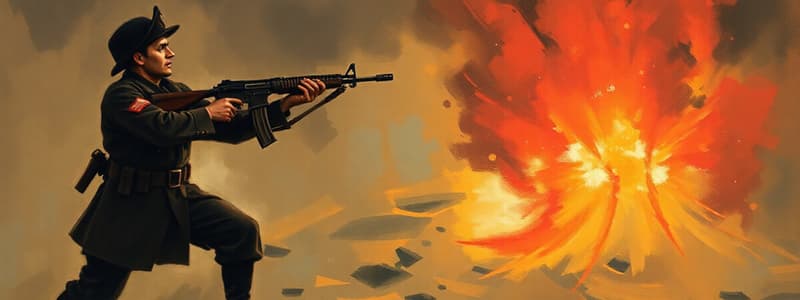Podcast
Questions and Answers
What is the primary document that outlines the force composition and flow requirements for a joint operation?
What is the primary document that outlines the force composition and flow requirements for a joint operation?
Which organization is responsible for the integration and synchronization of sustainment operations within a theater?
Which organization is responsible for the integration and synchronization of sustainment operations within a theater?
What are the four operational responsibilities of the TSC?
What are the four operational responsibilities of the TSC?
Which of these is NOT a characteristic of force tailoring?
Which of these is NOT a characteristic of force tailoring?
Signup and view all the answers
What are some of the common theater-level formations that facilitate operations during competition?
What are some of the common theater-level formations that facilitate operations during competition?
Signup and view all the answers
How do Theater Armies tailor forces to meet land force requirements?
How do Theater Armies tailor forces to meet land force requirements?
Signup and view all the answers
How does the TSC connect strategic enablers to tactical formations?
How does the TSC connect strategic enablers to tactical formations?
Signup and view all the answers
What is the main focus of the TSC in terms of support for Army forces?
What is the main focus of the TSC in terms of support for Army forces?
Signup and view all the answers
What is essential for Army forces to implement in case deterrence is not guaranteed?
What is essential for Army forces to implement in case deterrence is not guaranteed?
Signup and view all the answers
Why is coordination with the joint force critical for Army forces?
Why is coordination with the joint force critical for Army forces?
Signup and view all the answers
What role do host-nation capabilities play in Army force protection?
What role do host-nation capabilities play in Army force protection?
Signup and view all the answers
Which echelon must prepare to execute OPLANs?
Which echelon must prepare to execute OPLANs?
Signup and view all the answers
What is the foundation for executing OPLANs effectively?
What is the foundation for executing OPLANs effectively?
Signup and view all the answers
What must higher echelons consider for initial conflict stages?
What must higher echelons consider for initial conflict stages?
Signup and view all the answers
How do Army forces enhance deterrence against adversaries?
How do Army forces enhance deterrence against adversaries?
Signup and view all the answers
What should be done with forward deployed forces that cannot be adequately protected?
What should be done with forward deployed forces that cannot be adequately protected?
Signup and view all the answers
What must Army forces do to ensure credibility in deterring potential adversaries?
What must Army forces do to ensure credibility in deterring potential adversaries?
Signup and view all the answers
How should commanders prepare for operations under adversary threats?
How should commanders prepare for operations under adversary threats?
Signup and view all the answers
What complicates a commander's decision-making ability in a chemically contaminated environment?
What complicates a commander's decision-making ability in a chemically contaminated environment?
Signup and view all the answers
What is the role of USAID in humanitarian assistance?
What is the role of USAID in humanitarian assistance?
Signup and view all the answers
What was a significant operation conducted by U.S. forces in Liberia in 2014?
What was a significant operation conducted by U.S. forces in Liberia in 2014?
Signup and view all the answers
What is one key element for a formation's ability to operate under threats of weapons of mass destruction?
What is one key element for a formation's ability to operate under threats of weapons of mass destruction?
Signup and view all the answers
What was the composition of the joint force during the Operation United Assistance?
What was the composition of the joint force during the Operation United Assistance?
Signup and view all the answers
What is emphasized as critical for denying the adversary an advantage during a chemical or nuclear threat?
What is emphasized as critical for denying the adversary an advantage during a chemical or nuclear threat?
Signup and view all the answers
What is the primary goal of Foreign Internal Defense (FID) efforts?
What is the primary goal of Foreign Internal Defense (FID) efforts?
Signup and view all the answers
How do Security Force Assistance (SFA) activities differ from Foreign Internal Defense (FID) activities?
How do Security Force Assistance (SFA) activities differ from Foreign Internal Defense (FID) activities?
Signup and view all the answers
What is the overarching objective of security sector reform?
What is the overarching objective of security sector reform?
Signup and view all the answers
Which of the following is NOT included within the umbrella term of security sector reform?
Which of the following is NOT included within the umbrella term of security sector reform?
Signup and view all the answers
Who leads and provides oversight for security sector reform efforts?
Who leads and provides oversight for security sector reform efforts?
Signup and view all the answers
What role does the Army primarily play in security sector reform?
What role does the Army primarily play in security sector reform?
Signup and view all the answers
What foundational element is essential for U.S. nuclear capabilities?
What foundational element is essential for U.S. nuclear capabilities?
Signup and view all the answers
Which of the following best describes the integrated activities included in security sector reform?
Which of the following best describes the integrated activities included in security sector reform?
Signup and view all the answers
What is the primary intention of operations during competition below armed conflict?
What is the primary intention of operations during competition below armed conflict?
Signup and view all the answers
Which of the following best describes the adversary's approach during competition below armed conflict?
Which of the following best describes the adversary's approach during competition below armed conflict?
Signup and view all the answers
What are Army forces expected to do if deterrence fails?
What are Army forces expected to do if deterrence fails?
Signup and view all the answers
How do Army forces support combatant commanders during competition?
How do Army forces support combatant commanders during competition?
Signup and view all the answers
What potential issue arises from the tension created between the U.S. and adversaries during competition?
What potential issue arises from the tension created between the U.S. and adversaries during competition?
Signup and view all the answers
What is the role of theater armies in competition below armed conflict?
What is the role of theater armies in competition below armed conflict?
Signup and view all the answers
What is a critical aspect of Army operations in the context of competition below armed conflict?
What is a critical aspect of Army operations in the context of competition below armed conflict?
Signup and view all the answers
What is a key outcome that Army forces strive for during competition?
What is a key outcome that Army forces strive for during competition?
Signup and view all the answers
What is the primary purpose of the Security Force Assistance Brigades (SFAB)?
What is the primary purpose of the Security Force Assistance Brigades (SFAB)?
Signup and view all the answers
At which levels does the SFAB primarily advise partner forces?
At which levels does the SFAB primarily advise partner forces?
Signup and view all the answers
How do advisors in SFABs contribute to a CCDR's overall intelligence picture?
How do advisors in SFABs contribute to a CCDR's overall intelligence picture?
Signup and view all the answers
What is a significant role of a corps during competition in a CCDR's area of responsibility (AOR)?
What is a significant role of a corps during competition in a CCDR's area of responsibility (AOR)?
Signup and view all the answers
What is one of the expected contributions of the corps during large-scale combat operations?
What is one of the expected contributions of the corps during large-scale combat operations?
Signup and view all the answers
Which statement best describes the alignment of SFABs?
Which statement best describes the alignment of SFABs?
Signup and view all the answers
In addition to advising, what other activities can SFABs conduct?
In addition to advising, what other activities can SFABs conduct?
Signup and view all the answers
What kind of presence do SFABs provide in regions of strategic competition?
What kind of presence do SFABs provide in regions of strategic competition?
Signup and view all the answers
Study Notes
Operations During Competition Below Armed Conflict
- Competition below armed conflict occurs when an adversary's national interests clash with U.S. interests, and the adversary actively pursues them short of open armed conflict.
- The resulting tension between the two sides creates potential for violent escalation.
- Army forces contribute to competition below the threshold of armed conflict.
- Theater armies prepare and support combatant commanders (CCDRs) as they deter adversaries and achieve national objectives.
Overview of Operations During Competition
- Operations during competition aim to deter adversary action, set conditions for armed conflict under favorable terms when deterrence fails, and shape the operational environment with allies and partners.
- Army forces contribute to conventional deterrence through preparation for armed conflict, and cooperation with allies and partners to build capacity.
- Deliberate messaging of the will and capability for combat operations is a strong deterrent to adversaries.
- Interoperability with allies strengthens deterrence.
Adversary Methods During Competition
- Adversaries employ all of their national power instruments to pursue strategic interests without direct military confrontation.
- Adversaries often use nonmilitary methods like diplomatic efforts and infrastructure projects to exert influence, undermine political-military partnerships, and weaken U.S. influence.
- Adversaries may also employ proxy forces, unconventional warfare, and information warfare in covert actions.
Activities to Achieve Strategic Goals
- Adversaries employ a combination of non-military and military methods to pursue their interests, such as diplomatic efforts or military action.
- Proxy forces, often composed of paramilitary groups, special interest groups or religious groups, provide plausible deniability to state actors.
- To counteract adversaries, the Army focuses on disrupting their activities and strengthening cooperative relationships with allies and partners.
Activities to Counter a United States Response
- Adversaries may use information warfare, manipulation of relationships, and restrictions on access to dissuade a U.S. response.
- Precluding U.S. access can include deploying defensive systems, positioning missiles, and controlling critical infrastructure.
Studying That Suits You
Use AI to generate personalized quizzes and flashcards to suit your learning preferences.
Related Documents
Description
This quiz focuses on the strategies and operations conducted by Army forces during competition below armed conflict. It explores how these operations aim to deter adversary actions and prepare for potential conflict while collaborating with allies. Test your understanding of the dynamics involved in shaping the operational environment.





